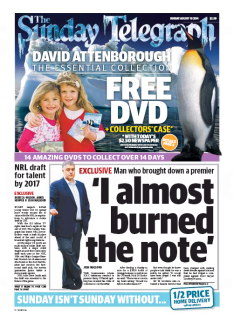ABCs: Sunday Tele falls below 500,000 copies, as print sales decline and digital levels off
 Australia’s most read print newspaper, News Corp’s The Sunday Telegraph has for the first time fallen below the important landmark of half a million copies, selling 488,432 editions last quarter, a decline of 9.8 per cent year-on-year.
Australia’s most read print newspaper, News Corp’s The Sunday Telegraph has for the first time fallen below the important landmark of half a million copies, selling 488,432 editions last quarter, a decline of 9.8 per cent year-on-year.
The top selling tabloid was far from the only newspaper to post such print circulation declines, with some newspapers, such as The Age’s weekday edition declining in excess of 20 per cent, while digital subscriptions recorded steady but slowing growth, among the titles which were submitted for scrutiny to the Audit Bureau of Circulations.
Today’s figures reveal the Fairfax weekday edition of The Age is in percentage terms the worst affected newspaper, losing 28,761 sales, with falls of 20.20 per cent while the Saturday edition fell 8.8 per cent and the Sunday Age was down 10.40 per cent. The numbers for The Age’s and Sydney Morning Herald’s website paywalls, which were launched in Australia on July 2 last year, show continuing growth in digital with The Age up some 80,245 digital subscribers.
 However, the growth appears to be levelling off across both Fairfax and News Corp titles (around four to eight per cent quarter on quarter) and is not replacing the number of print readers lost once the multiplier or “pass-on” rate suggested by the Enhanced Media Metrics Australia (EMMA) data released on Monday is applied to each print copy sold.
However, the growth appears to be levelling off across both Fairfax and News Corp titles (around four to eight per cent quarter on quarter) and is not replacing the number of print readers lost once the multiplier or “pass-on” rate suggested by the Enhanced Media Metrics Australia (EMMA) data released on Monday is applied to each print copy sold.


Oh dear….have someone ready to turn the lights out! SOON!
I think i will “pass on” EMMA’s stats.
A theory as to why the Tele is going down the gurgle.
When under scrutiny for their preposterous bias towards the coalition, editors of Murdoch’s rags often claim they’re just giving the people what they want to read.
These two things no longer align. Can’t have it both ways Rupert, pick a side.
According to EMMA, newspaper readership has gone up. Surprise, surprise, guess who is funding EMMA?
I’d back fairfax to do better than news in long term when print dies completely except for mthly mags. at least FFX dig subs are at a level of some sort of materiality. news doesn;t look to good esp when the Hun is relying on bundlign of supercoach to drive its. turns out A/Bs more likely to subscribe for content than Hun/Tele audience.
I am amazed that the LNP’s Sunday newsletter has this many copies to be honest. Murdoch hates windmills, oh do fck off Rupert and go and live in America.
Fairfax’s digital first strategy is clearly going nowhere. Have alook at the revenues reported in this week. These audience numbers tell us they are cratering in print and adding little online (certainly nothing that can pay the bills). Note also that the product effects are really starting to bite and even the business niche is tanking (print now down to 60k – with a noticeable stack at the airport these days) and digital numbers secret.
The serious problem at Fairfax is that none of them are any good at delivering a product that people will buy. So they focus on cost, which of course is now random.
10% falls at the Tele and yet every day they say in their own paper ‘More readers reading the Tele! Beating the SMH!’. It’s clearly just a fib. Their circ is falling heavily, along with the others. Meanwhile, the SMH has more than 1 million more readers in total. Never mentioned.